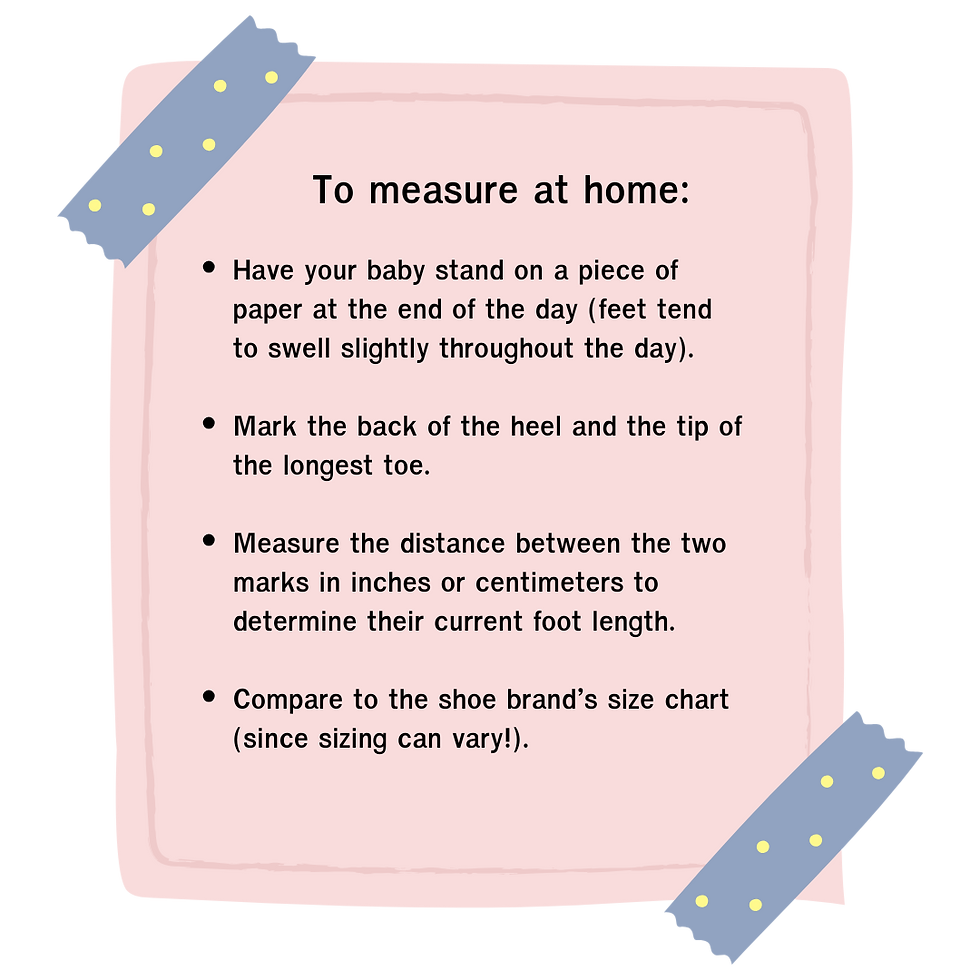How to Choose Baby’s First Shoes: My Checklist as a Pediatric PT
- Rachael Carreon PT, DPT

- May 12
- 4 min read
When to start your little one in shoes, what to look for, and what to avoid.
If you’ve ever wandered down the baby shoe aisle, you know the options are nearly endless.
Between the price tags, the explosion of options, and not knowing what your baby actually needs, it can get overwhelming FAST.
Do they need shoes if they’re not walking? Are those unicorn high-tops too stiff? What about Crocs?
Don’t worry - I’ve got you. Let’s walk (see what I did there?) through what to look for, what to skip, and when your baby actually needs shoes in the first place.
Does My Baby Even Need Shoes Yet?
Here’s the deal: if your baby isn’t walking independently yet, they don’t need structured shoes.
Barefoot is best for as long as possible - at home, in safe spaces, and especially on different textures. It helps build strong, flexible feet and improves balance, coordination, and muscle activation. I
If you need something for warmth or protection, stick with soft booties or grippy socks that won’t get in the way.
But once your little one is taking independent steps consistently (usually somewhere between 12–18 months), it’s time for a real pair of shoes - something to support and protect those sweet (but very busy) feet outdoors.
What About Sock Shoes?
Sock shoes or barefoot shoes may seem like a comfy in-between option, but they often lack the structure and grip needed for safe, effective movement.
They can bunch up, slide around, or limit how the foot muscles engage. For babies and toddlers who are learning to stand, cruise, or take early steps, barefoot is still the better choice whenever it’s safe—those little feet need room to move, stretch, and build strength.
Save sock shoes for occasional use, and let those toes do the work of learning and growing.
What if My Baby is ALMOST Walking?
If your baby has been cruising for a couple of months - walking along furniture, pushing toys, or standing with support - but hasn’t taken the leap to solo steps, a bit of extra stability can help.
In those cases, I often recommend a lightweight high-top shoe with a flexible sole and a secure fit (like this one from Stride Rite).
It won’t make them walk, but it can give their ankles and balance a gentle boost while they build confidence.
What to Look for in a First Shoe (The Non-Negotiables)
Here’s your quick checklist for healthy little feet:
✅ Flexible Sole – Your baby’s foot is still developing, so the sole should bend easily to allow natural movement and strengthening. If you can’t bend it with one hand, it’s too stiff!
✅ Wide Toe Box – Those little toes need room to splay and grip as your baby balances. No pointy-toed fashion statements here.
✅ Straight Sole (Last) - Flip the shoe over. Can you draw a straight line from heel to toe? Perfect. Baby feet are naturally widest at the toes - shoes with a curved last can squish their toes and affect how they learn to walk!
✅ Lightweight – Heavy = clunky. Heavy shoes make it harder for babies to walk naturally. Look for lightweight materials that won’t weigh them down.
✅ Secure Fit (Think Velcro or Adjustable Straps) – Slip-ons are cute, but not super functional for new walkers. Go for something that stays on and doesn’t shift around.
✅ Grippy, Thin Outsole – You want traction without bulk. Think “feel the ground beneath your feet but don’t slip on it.”

What to Avoid 🚫
❌ Thick, Stiff Soles - They block sensory feedback and make walking harder. If it’s hard for you to bend, it’s even harder for them.
❌ Narrow Toe Boxes - No baby needs squished toes. It’s not just uncomfortable - it can affect long-term development of their little feet.
❌ Heavy or Clunky Styles (Yes, even those fancy dress shoes) - You get about 8–12 weeks of wear before they outgrow a pair. Skip the fashion statements in favor of function.
❌ Crocs (Sorry!) - They’re easy, yes. But they’re also floppy, sweaty, and offer zero support for early walkers. Save them for splash pads when your toddler’s walking is more mature.
One More Thing: Make Sure Those Shoes Actually Fit
It’s tempting to grab shoes a size too big so they “last longer,” but oversized shoes can be just as problematic as tight ones. They can cause tripping, blisters, and poor alignment.
A well-fitting shoe is key to supporting your baby’s development.
Measure your baby’s feet every 6–8 weeks (seriously, they grow FAST) and adjust as needed.

My Favorite Shoes for Babies & Toddlers
Still not sure what shoes to pick? I’ve rounded up my go-to shoe recommendations (including high-tops, sandals, and budget-friendly picks!) in my Amazon storefront.
Bottom Line: Keep It Simple
Choosing shoes for your baby doesn’t have to be complicated. When in doubt, go barefoot at home, and when it’s time for shoes, choose ones that are lightweight, supportive, and built for real little feet - not just cute Instagram pictures. Bonus if they aren’t too expensive.
By following these tips, you can make informed decisions about your children’s footwear, promoting healthy foot development and preventing potential issues.

It’s especially important to follow this list if your child has flat, pronated feet. The best kids shoes with a rigid arch and heel cup support will make a big difference.
Your baby’s feet are literally the foundation of how they move through the world. Let’s help them start off strong. 👣
Still have questions about what shoes are right for YOUR baby or how to help them take those precioous first steps? Reach out today!





Comments